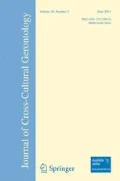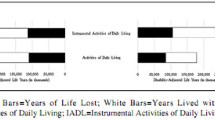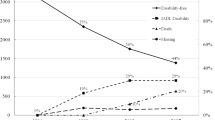Abstract
The objective of this paper is to examine short-term trends in the prevalence of limitation in Activities of Daily Living (ADL), Instrumental Activities of Daily Living (IADL) and Nagi physical functioning tasks among persons age 60 years or older in five Asian settings: Indonesia, the Philippines, Singapore, Taiwan and the Beijing Municipality. The data come from recent panel surveys of older adults that span a period of 3–4 years during the mid to late 1990s. Results suggest a general trend toward an increase in functional limitation in four of the five settings, with the most pronounced increases occurring for the Nagi functioning tasks. Compositional differences in the population accounted for little of the increase. The paper discusses the potential implications of these results and places them in the context of past and current trends in functional limitation observed in the United States.
Similar content being viewed by others
References
Alam, M. (2006). Ageing in India: Socio-economic and health dimensions. New Delhi, India: Academic Foundation.
Brown, J. W., Liang, J., Krause, N., Akiyama, H., Sugisawa, H., & Fukaya, T. (2002). Transitions in living arrangements among elders in Japan: Does health make a difference? Journal of Gerontology: Social Sciences, 57(4), 209–220.
Colvez, A., & Blanchet, M. (1981). Disability trends in the United States population 1966–76: Analysis of reported causes. American Journal of Public Health, 71(5), 464–471.
Crimmins, E. M., Saito, Y., & Reynolds, S. L. (1997). Further evidence on recent trends in the prevalence and incidence of disability among older Americans from two sources: The LSOA and the NHIS. Journal of Gerontology: Social Sciences, 52B(2), 59–71.
Department of Social Medicine (1995). Report of the Beijing multidimentional longitudinal study on aging. Beijing: Beijing Geriatric Clinical and Research Center.
Freedman, V. A., Crimmins, E., Schoeni, R. F., Spillman, B. C., Aykan, H., Kramarow, E., et al. (2004). Resolving inconsistencies in trends in old-age disability: Report from a technical working group. Demography, 41(3), 417–441.
Freedman, V. A., & Martin, L. G. (1998). Understanding trends in functional limitations among older Americans. American Journal of Public Health, 88(10), 1457–1462.
Freedman, V. A., Martin, L. G., & Schoeni, R. F. (2002). Recent trends in disability and functioning among older adults in the United States. Journal of the American Medical Association, 288(24), 3137–3146.
Fries, J. F. (1980). Aging, natural death, and the compression of morbidity. New England Journal of Medicine, 303(3), 130–135.
Gruenberg, E. M. (1977). The failure of success. Milbank Memorial Fund Quarterly, 55(1), 3–24.
Gu, D., & Zeng, Y. (2004). Sociodemographic effects on the onset and recovery of ADL disability among Chinese oldest-old. Demographic Research, 11(1), 1–42.
Hermalin, A. I. (2000). Ageing in Asia: Facing the crossroads. Comparative Study of the Elderly in Asia Research Reports, No. 00–55. Ann Arbor, MI: Population Studies Center, University of Michigan.
Hermalin, A. I. (2002). The well being of the elderly in Asia: A four-country comparative study. Ann Arbor, Michigan: University of Michigan Press.
Interministerial Committee on the Ageing Population (1999). Report of the Interministerial Committee on the Ageing Population. Singapore: Ministry of Community Development.
Jacqmin-Gadda, H., Fabrigoule, C., Commenges, D., & Dartigues, J. F. (1997). A 5-year longitudinal study of the mini-mental state examination in normal aging. American Journal of Epidemiology, 145, 498–506.
Knodel, J., Ofstedal, M. B., & Hermalin, A. I. (2002). Demographic, socioeconomic and cultural context. In A. I. Hermalin (Ed.), The well-being of the elderly in Asia: A four-country comparative study (pp. 362–416). Ann Arbor, MI: University of Michigan Press.
Kramer, M. (1980). The rising pandemic of mental disorders and associated chronic diseases and disabilities. Acta Psychiatrica Scandinavica, 62(Suppl. 285), 282–297.
Liang, J., Liu, X., & Gu, S. (2001). Transitions in functional status among older people in Wuhan, China: Socioeconomic differentials. Journal of Clinical Epidemiology, 54, 1126–1138.
Lin, D. Y., & Wei, L. J. (1989). The robust inference for the Cox proportional hazards model. Journal of the American Statistical Association, 84, 1074–1078.
Manton, K. G. (1982). Changing concepts of morbidity and mortality in the elderly population. Milbank Memorial Fund Quarterly, 60, 183–244.
Manton, K. G. (1997). Chronic disability trends in elderly United States populations: 1982–1994. Proceedings of the National Academy of Sciences of the United States of America. Washington, D.C.: National Academy of Sciences.
Manton, K. G., Corder, L. S., & Stallard, E. (1993). Estimates of change in chronic disability and institutional incidence and prevalence rates in the U.S. elderly population from the 1982, 1984, and 1989 National Long Term Care Survey. Journal of Gerontology: Social Sciences, 48(4), S153–S166.
Mathers, C. D., Murray, C. J. L., Lopez, A. D., Salomon, J. A., & Sadana, R. (2003). Global patterns of health expectancy in the year 2000. In J. M. Robine, C. Jagger, C. D. Mathers, E. M. Crimmins, & R. M. Suzman (Eds.), Determining health expectancies (pp. 335–358). West Sussex, UK: Wiley.
Mayhew, L. (1999). Health and welfare services expenditure in an aging world. Interim Report. International Institute for Applied Systems Analysis. Number IR-99-035/September.
Ofstedal, M. B., Madans, J. H., & Feldman, J. J. (1994). Estimates of change in functional limitation in the U.S. elderly population. Paper presented at the Annual Meeting of the Population Association of America, Miami.
Ogawa, N., & Retherford, R. D. (1997). Shifting costs of caring for the elderly back to families in Japan: Will it work? Population and Development Review, 23(1), 59–94.
Rajan, S. I., Mishra, U. S., & Sarma, P. S. (2001). Health concerns among India’s elderly. International Journal of Aging and Human Development, 53(3), 191–204.
Schoeni, R. F., Freedman, V. A., & Wallace, R. B. (2001). Persistent, consistent, widespread, and robust? Another look at recent trends in old-age disability. Journal of Gerontology: Social Sciences, 56B(4), 206–218.
Schoeni, R. F., Liang, J., Bennett, J., Sugisawa, H., Fukaya, T., & Kobayashi, E. (2006). Trends in old-age functioning and disability in Japan, 1993–2002. Population Studies, 60(1), 39–53.
Tang, Z., Jiang, J. M., & Futatsuka, M. (2002). An evaluation of transition in functional states among the elderly in Beijing, China. Environmental Health and Preventive Medicine, 7, 211–216.
Unger, J. M., van Belle, G., & Heyman, A. (1999). Cross-sectional versus longitudinal estimates of cognitive change in non-demented older people: A CERAD study. Journal of the American Geriatrics Society, 47, 559–563.
United Nations, Department of Economic and Social Affairs (2005). World Population Prospects, the 2004 Revision. Vol 1: Comprehensive Tables ST/ESA/SER.A/177; Vol. II: Sex and Age Distribution of the World Population ST/ESA/SER/A/180. New York: United Nations.
Verbrugge, L. M. (1984). Longer life but worsening health? Trends in health and mortality of middle aged persons. Milbank Memorial Fund Quarterly, 62(3), 475–519.
Waidmann, T., Bound, J., & Schoenbaum, M. (1995). The illusion of failure: Trends in the self-reported health of the U.S. elderly. The Milbank Quarterly, 73(2), 253–287.
Waidmann, T. A., & Liu, K. (2000). Disability trends among elderly persons and implications for the future. Journal of Gerontology: Social Sciences, 55B(5), 298–307.
Zelinski, E. M., & Burnight, K. P. (1997). Sixteen-year longitudinal and time lag changes in memory and cognition of older adults. Psychology and Aging, 12, 503–513.
Zeng, Y., Vaupel, J. W., Zhenyu, X., Chunyuan, Z., & Yuzhi, L. (2002). Sociodemographic and health profiles of the oldest old in China. Population and Development Review, 28(2), 251–273.
Zimmer, Z., Liu, X., Hermalin, A., & Chuang, Y. L. (1998). Educational attainment and transitions in functional status among older Taiwanese. Demography, 35(3), 361–375.
Zimmer, Z., Martin, L. G., & Chang, M-C. (2002). Changes in functional limitations and survival among the elderly in Taiwan: 1993, 1996 and 1999. Population Studies, 3, 265–276.
Zimmer, Z., Martin, L. G., & Lin, H. S. (2005). Determinants of old-age mortality in Taiwan. Social Science and Medicine, 60(2), 457–470.
Zimmer, Z., Natividad, J. N., Ofstedal, M. B., & Lin, H. S. (2002). Physical and mental health of the elderly. In A. I. Hermalin (Ed.), The Well-Being of the Elderly in Asia: A Four-Country Comparative Study (pp. 362–416). Ann Arbor, MI: University of Michigan Press.
Acknowledgments
This research was undertaken as part of the Comparative Study of Health Transitions in Later Life, supported by parallel grants from the National Institute on Aging, R01 AG20072-01 and R01 AG20063-01. An earlier version of this paper was presented at the Annual Meeting of the Gerontological Society of America, Washington, DC, November 2004. We wish to thank the editor and three anonymous reviewers for their excellent comments and suggestions.
Author information
Authors and Affiliations
Corresponding author
Appendix
Appendix
Table VII
Rights and permissions
About this article
Cite this article
Ofstedal, M.B., Zimmer, Z., Hermalin, A.I. et al. Short-term Trends in Functional Limitation and Disability Among Older Asians: A Comparison of Five Asian Settings. J Cross Cult Gerontol 22, 243–261 (2007). https://doi.org/10.1007/s10823-006-9025-z
Received:
Accepted:
Published:
Issue Date:
DOI: https://doi.org/10.1007/s10823-006-9025-z




